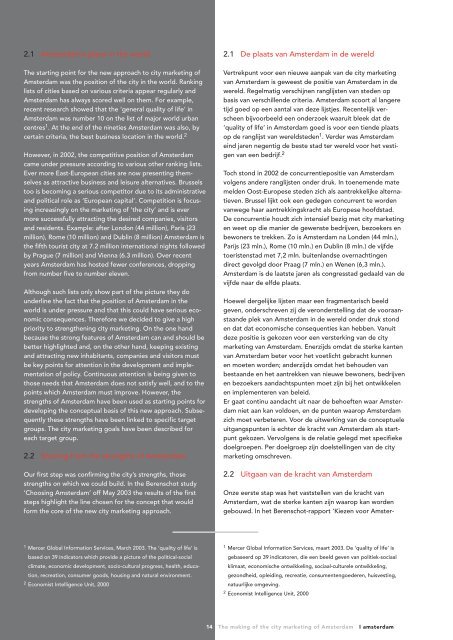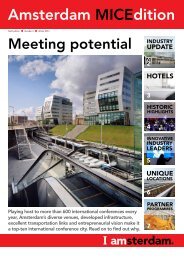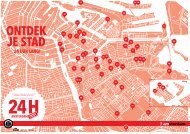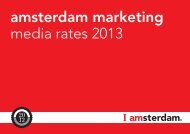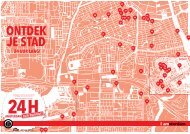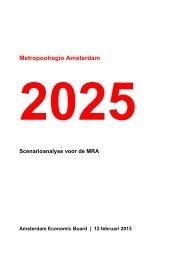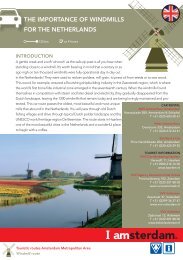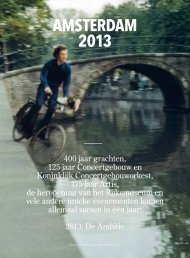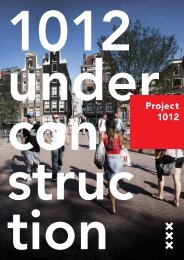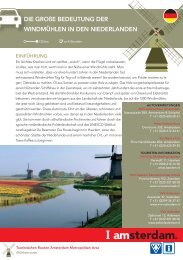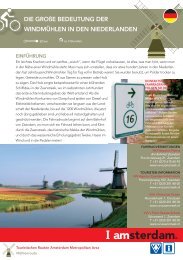citymarketing 5 - I amsterdam
citymarketing 5 - I amsterdam
citymarketing 5 - I amsterdam
You also want an ePaper? Increase the reach of your titles
YUMPU automatically turns print PDFs into web optimized ePapers that Google loves.
2.1 Amsterdam’s place in the world<br />
The starting point for the new approach to city marketing of<br />
Amsterdam was the position of the city in the world. Ranking<br />
lists of cities based on various criteria appear regularly and<br />
Amsterdam has always scored well on them. For example,<br />
recent research showed that the ‘general quality of life’ in<br />
Amsterdam was number 10 on the list of major world urban<br />
centres 1 . At the end of the nineties Amsterdam was also, by<br />
certain criteria, the best business location in the world. 2<br />
However, in 2002, the competitive position of Amsterdam<br />
came under pressure according to various other ranking lists.<br />
Ever more East-European cities are now presenting themselves<br />
as attractive business and leisure alternatives. Brussels<br />
too is becoming a serious competitor due to its administrative<br />
and political role as ‘European capital’. Competition is focusing<br />
increasingly on the marketing of ‘the city’ and is ever<br />
more successfully attracting the desired companies, visitors<br />
and residents. Example: after London (44 million), Paris (23<br />
million), Rome (10 million) and Dublin (8 million) Amsterdam is<br />
the fifth tourist city at 7.2 million international nights followed<br />
by Prague (7 million) and Vienna (6.3 million). Over recent<br />
years Amsterdam has hosted fewer conferences, dropping<br />
from number five to number eleven.<br />
Although such lists only show part of the picture they do<br />
underline the fact that the position of Amsterdam in the<br />
world is under pressure and that this could have serious economic<br />
consequences. Therefore we decided to give a high<br />
priority to strengthening city marketing. On the one hand<br />
because the strong features of Amsterdam can and should be<br />
better highlighted and, on the other hand, keeping existing<br />
and attracting new inhabitants, companies and visitors must<br />
be key points for attention in the development and implementation<br />
of policy. Continuous attention is being given to<br />
those needs that Amsterdam does not satisfy well, and to the<br />
points which Amsterdam must improve. However, the<br />
strengths of Amsterdam have been used as starting points for<br />
developing the conceptual basis of this new approach. Subsequently<br />
these strengths have been linked to specific target<br />
groups. The city marketing goals have been described for<br />
each target group.<br />
2.2 Starting from the strenghts of Amsterdam<br />
Our first step was confirming the city’s strengths, those<br />
strengths on which we could build. In the Berenschot study<br />
‘Choosing Amsterdam’ off May 2003 the results of the first<br />
steps highlight the line chosen for the concept that would<br />
form the core of the new city marketing approach.<br />
1 Mercer Global Information Services, March 2003. The ‘quality of life’ is<br />
based on 39 indicators which provide a picture of the political-social<br />
climate, economic development, socio-cultural progress, health, education,<br />
recreation, consumer goods, housing and natural environment.<br />
2 Economist Intelligence Unit, 2000<br />
2.1 De plaats van Amsterdam in de wereld<br />
Vertrekpunt voor een nieuwe aanpak van de city marketing<br />
van Amsterdam is geweest de positie van Amsterdam in de<br />
wereld. Regelmatig verschijnen ranglijsten van steden op<br />
basis van verschillende criteria. Amsterdam scoort al langere<br />
tijd goed op een aantal van deze lijstjes. Recentelijk verscheen<br />
bijvoorbeeld een onderzoek waaruit bleek dat de<br />
‘quality of life’ in Amsterdam goed is voor een tiende plaats<br />
op de ranglijst van wereldsteden 1 . Verder was Amsterdam<br />
eind jaren negentig de beste stad ter wereld voor het vestigen<br />
van een bedrijf. 2<br />
Toch stond in 2002 de concurrentiepositie van Amsterdam<br />
volgens andere ranglijsten onder druk. In toenemende mate<br />
melden Oost-Europese steden zich als aantrekkelijke alternatieven.<br />
Brussel lijkt ook een gedegen concurrent te worden<br />
vanwege haar aantrekkingskracht als Europese hoofdstad.<br />
De concurrentie houdt zich intensief bezig met city marketing<br />
en weet op die manier de gewenste bedrijven, bezoekers en<br />
bewoners te trekken. Zo is Amsterdam na Londen (44 mln.),<br />
Parijs (23 mln.), Rome (10 mln.) en Dublin (8 mln.) de vijfde<br />
toeristenstad met 7,2 mln. buitenlandse overnachtingen<br />
direct gevolgd door Praag (7 mln.) en Wenen (6,3 mln.).<br />
Amsterdam is de laatste jaren als congresstad gedaald van de<br />
vijfde naar de elfde plaats.<br />
Hoewel dergelijke lijsten maar een fragmentarisch beeld<br />
geven, onderschreven zij de veronderstelling dat de vooraanstaande<br />
plek van Amsterdam in de wereld onder druk stond<br />
en dat dat economische consequenties kan hebben. Vanuit<br />
deze positie is gekozen voor een versterking van de city<br />
marketing van Amsterdam. Enerzijds omdat de sterke kanten<br />
van Amsterdam beter voor het voetlicht gebracht kunnen<br />
en moeten worden; anderzijds omdat het behouden van<br />
bestaande en het aantrekken van nieuwe bewoners, bedrijven<br />
en bezoekers aandachtspunten moet zijn bij het ontwikkelen<br />
en implementeren van beleid.<br />
Er gaat continu aandacht uit naar de behoeften waar Amsterdam<br />
niet aan kan voldoen, en de punten waarop Amsterdam<br />
zich moet verbeteren. Voor de uitwerking van de conceptuele<br />
uitgangspunten is echter de kracht van Amsterdam als startpunt<br />
gekozen. Vervolgens is de relatie gelegd met specifieke<br />
doelgroepen. Per doelgroep zijn doelstellingen van de city<br />
marketing omschreven.<br />
2.2 Uitgaan van de kracht van Amsterdam<br />
Onze eerste stap was het vaststellen van de kracht van<br />
Amsterdam, wat de sterke kanten zijn waarop kan worden<br />
gebouwd. In het Berenschot-rapport ‘Kiezen voor Amster-<br />
1 Mercer Global Information Services, maart 2003. De ‘quality of life’ is<br />
gebaseerd op 39 indicatoren, die een beeld geven van politiek-sociaal<br />
klimaat, economische ontwikkeling, sociaal-culturele ontwikkeling,<br />
gezondheid, opleiding, recreatie, consumentengoederen, huisvesting,<br />
natuurlijke omgeving.<br />
2 Economist Intelligence Unit, 2000<br />
14 The making of the city marketing of Amsterdam I <strong>amsterdam</strong>


